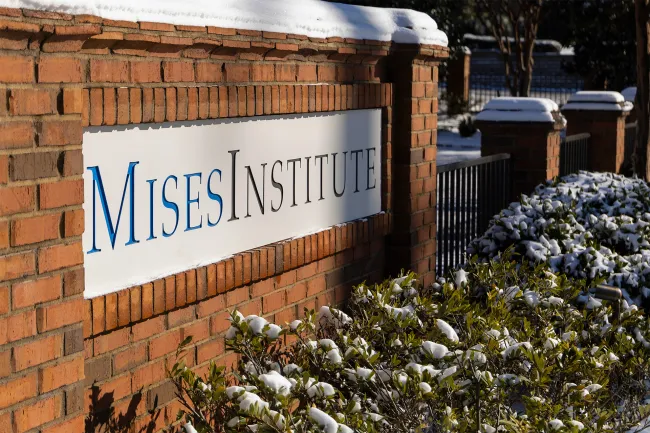President Donald Trump this morning reiterated that he thinks US monetary policy should be more like that of the European Central Bank. Trump also complained that Fed Chairman Jerome Powell and the Fed’s Federal Open Market Committee (FOMC) was unlikely to cut the target federal funds rate even though Trump believes the target should be lowered. According to Fox News:
We have a stupid person, frankly, at the Fed,“ Trump said. “He probably won’t cut today. Europe had 10 cuts and we had none. I guess he’s a political guy, I don’t know. He’s a political guy who’s not a smart person. But he’s costing the country a fortune.”
Trump’s desire for even more monetary inflation than the Fed has already created has long contributed to Trump’s ongoing criticism of the Federal Reserve. As of today, the Fed has held its target rate at 4.5 percent. The Fed previously cut its target rate by 50 basis points, lowering the target from 5.0 percent to 4.5 percent over the course of two months last fall.

As Trump predicted, the FOMC today did not lower the target rate, and maintained a target of 4.5 percent. Much of the FOMC’s stated rationale on this, according to its press release, is that “Inflation remains somewhat elevated.” In this respect the Fed isn’t wrong. In spite of his claims made last fall that price inflation would rapidly return to the Fed’s 2-percent target, that prediction has proven unfounded. Seven months later, core CPI inflation remains at 2.8 percent, and the most recent reading of the Fed’s favorite inflation metric, PCE, is at 2.5 percent. It’s clear that the Fed was simply wrong about the trajectory of price inflation.
Indeed, at this month’s meeting, the FOMC members increased their aggregate estimate for overall PCE inflation for 2025. Last March, the committee’s estimate for the year was 2.7 percent. This month, that estimate increased to 3.1 percent.
From the June Summary of Economic Projections:

On the other hand, the future is not simply one of growth-fueled price inflation. The FOMC also downgraded its estimates for growth this month. The committee decreased its estimate for real GDP growth in 2025, lowering it from the March estimate of 1.7 percent down to 1.4 percent in the most recent estimate. At the same time, the committee raised its unemployment projection for the year. In March, the projection for 2025 was 4.4 percent. This week the FOMC raised that to 4.5 percent.
Trump and MAGA continue to repeatedly beat the drum for more Fed activism in lowering the target interest rate because both see lower interest rates as politically advantageous for Trump. Trump and his people want more monetary stimulus so Trump can point to inflation-fueled rising asset prices (i.e., stocks) and claim some sort of economic victory. To push this policy, Trump insists that there is no longer any danger of price inflation, so there’s no reason to not pump easy money, and lots of it. Thus, Trump this morning implied that the only reason Powell isn’t increasing the target rate is because “he’s a political guy.”
He’s not wrong. Powell, like all Fed chairmen, is indeed a “political guy.” (There is no such thing as an “independent” Fed.) From the perspective of a central banker, however, there’s nothing particularly outlandish about the Fed’s current decision to do nothing.
If the FOMC really believes its projections, then the committee is not expecting economic stagnation to create significant deflation. Rather, the FOMC projections point to a stagflationary trend with both stubborn price inflation and weak growth.
Of course, it’s impossible to know what FOMC members actually believe, but in this case, “doing nothing” is perfectly reasonable. In fact, if the Fed would “do nothing” more often, we’d have much less price inflation and much less of a distorted bubble economy.
Unfortunately, MAGA-Trump boosters aren’t concerned with economic fundamentals or with avoiding inflationary malaise. Their overwhelming priority appears to be nothing much more than “make number go up” so Trump can claim he made the stock market go up or that he increased GDP. Thus, MAGA and Trump push for more monetary inflation to further goose asset prices, heedless of the fact that this impoverishes ordinary people through price inflation.
One can only hope that the Fed continues to do nothing. Indeed, it should do even less and allow free-floating interest rates. Were the market allowed to function, interest rates are almost sure to go up since we are still a long way from recovering the saving and investment that is necessary to push down interest rates in a relatively free market. That saving and investment was eviscerated by 16 years of quantitative easing and ultra-low-interest rate policy. Thanks to the sort of inflationary policy Trump prefers, it will take years to rebuild the economy on a stable foundation of saving and investment, rather than on mountains of easy-money-fueled bubbles.
Sadly, we can’t count on any principled hawkishness from the Fed on this. As soon as a recession or financial crisis becomes undeniable, the Fed will hit the panic button and go right back to its usual methods of bailouts, inflation, and asset purchases. The Fed is indeed fundamentally political, after all. In the meantime, however, there’s no reason to push the inflation button just because Trump wants a boost in the polls.


